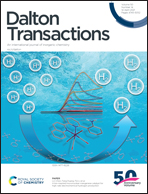An ultra-sensitive selective fluorescent sensor based on a 3D zinc-tetracarboxylic framework for the detection and enrichment of trace Cu2+ in aqueous media†
Abstract
Herein, a novel and fluorescent zinc-organic framework sensor [Zn3(μ3-Hbptc)2(μ2-4,4′-bpy)2(H2O)4]n·2nH2O (1) (H4bptc = 2,3,3′,4′-biphenyl tetracarboxylic acid, 4,4′-bpy = 4,4′-bipyridine) is synthesized and characterized, demonstrating its excellent fluorescence performance for Cu2+ detection and the enrichment of Cu2+ in aqueous media. The fluorescence intensity of 1 can be selectively quenched by Cu2+ in a linear range of Cu2+ concentrations of 0–0.7 μM. The limit of detection (LOD) value is as low as 32.4 nM, which is superior to those of most of the fluorescent sensors based on metal–organic frameworks (MOFs). It is also far below the maximum allowable concentration of Cu2+ in drinking water as defined by the U.S. Environmental Protection Agency (EPA) and the World Health Organization (WHO), so it is employed for the detection of Cu2+ in actual water samples. More importantly, the nature of the interaction between the active coordination site (COO−) of 1 and Cu2+ determines the quenching mechanism, that is Cu2+ in the analyte is captured by MOF 1, which has been investigated by ICP, luminescence, UV-vis, XPS, and lifetime studies. Besides, the chemosensor shows regeneration performance without the loss of performance in five consecutive cycles. So MOF 1 is a simple and convenient probe used not only for the rapid detection but also for the enrichment of trace amounts of Cu2+ in aqueous media, and the application can be further extended to a variety of environmental and biological analysis processes.



 Please wait while we load your content...
Please wait while we load your content...